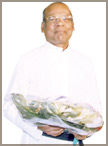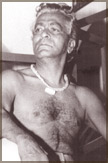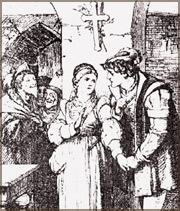|
DAILY NEWS ONLINE |
|
|
|
OTHER EDITIONS |
|
|
|
|
|
|
|
|
|
OTHER LINKS |
|
|
|
|
|
|
 |
|
Centre for Performing Arts completes 40 years
|
|
|
The Thirumarai Kala Mandram which conducted all its cultural activities with the help of the young people brought together from villages and towns in the Northern Province expanded its activities in the late 1980s and opened new branches in the region. It also took a new name 'Centre for Performing Arts' that reflected the growing reach and diversity of its programmes.
In 1990, the 'Centre for Performing Arts' opened a co-ordinating office in Colombo to expand the work in the southern Sri Lanka where it is now known by the additional name Ranga Kala Kendraya. Since then the Colombo office has become the co-ordinating centre for branch programmes all over Sri Lanka and in a dozen cities in Asia, Europe, North America and Australia.
Currently the Colombo office is the hub for regional and national programmes, information and public relations and also programme development and overall co-ordination.
In 2002, reflecting the increased scope of its work 'Centre for Performing Arts' improved its structures and became an official NGO, certified by the Ministry of Social Services.
The CPA remains one of the few cultural organisations that embrace all Sri Lankan ethnicities and languages bringing people together to learn and play and develop deep understanding and appreciation of each others' traditions.
The CPA productions provide opportunities for new connections to develop each others' inter-cultural activities and also communities where different ethnic groups live in mutual isolation, ignorance and mistrust.
At the same time the CPA performances have provided tens of thousands in the audience with messages about the terrible impact of violence and the foundations for peace in mutual respect.
For this reason CPA continues to have strong partnership with other organisations like humanitarian agencies and also with writers and artistes committed to peace.
The CPA's major activities include the annual children's and youth peace pageant in Colombo, children's peace camp in Trincomalee, three-day arts festival in Jaffna, children's festival in Poland, peace education and traditional cultural arts training.
Besides the 'Centre for Performing Arts' held a capacity building workshop with a consultant recommended by Caritas, Australia, carried out over a hundred
...local, regional and national programmes pertaining to peace in Sri Lanka and also performed humanitarian work in tsunami affected areas.
Professor Rev. Fr. N. M. Saveri, Director of the CPA was honoured with the 'Catholic Media Award' for his selfless, admirable and inestimable service in the promotion of peace through inter-cultural activities.
Further, Prof. Rev. Fr. N. M. Saveri will also be celebrating his forty third priestly ordination anniversary on July 1, 2005 with a Eucharistic service at SEDEC, Borella.
He was ordained prior in Rome on 1st July 1962. The Centre for Performing Arts from 20 centres in Sri Lanka will join him in this thanksgiving service. Thereafter a variety of entertainment will be presented by CPA children and youth on that day at 7 p.m. at New Kathiresan Hall, Bambalapitiya.
In fact, Prof. Rev. Fr. Saveri's academic brilliance, his persuasive eloquence, his missionary spirit, his bubbling enthusiasm for the promotion of peace among all communities are remarkable and was highly commended and immensely appreciated by all communities and denominations living in Sri Lanka and abroad.
The mission of the 'Centre for Performing Arts' is to promote peace, justice and equality among all communities, protect and nurture the rights and duties of children, help to heal the wounds of the war and the trauma of natural disaster, create opportunity for inter-cultural exchange among Sri Lanka's region, eliminate social and gender discrimination and promote the rights of women' to encourage artists to become agents of social peace and development.
With the view to promote the rights of women the CPA held recently a women's convention at Bandarawela Town Council hall in which more than 250 women from 20 regional centres of the CPA participated.
In fact, this convention in which Sinhala and Tamil women mingled together with the view to bring about peace captivated the hearts and minds of everyone.
Indeed it was a historical and memorable one and this convention symbolised and confirmed a new beginning - the beginning of reconciliation between the communities looking for peace and the beginning of the end of bitterness and hatred.
Furthermore, the CPA programs have always brought children and youths together irrespective of ethnicity, caste, religion and regions.
Undoubtedly, the CPA which completes 40 years in the sphere of art and culture stands not merely as an institution - a kingdom of mathematical wisdom, but also as a resilient tradition and an indomitable spirit destined to remain strong and sound for millenniums.
Founded by Kala Bhushana P.D. Ratnapala :
Kumudu Kala Peetaya turns 34
ELABORATE arrangements are being made to celebrate the 34th anniversary of "Kumudu Kala Peetaya" - Kandy on July 2, at Hindu Cultural Centre, Kandy, under the patronage of famous traditional Kandyan Dancing Artiste Sri Lanka Tilake, Nartanapathi Peter Surasena, who has received Presidential awards for best performance in the Kandy Perahera for nearly two decades.
|
Kumudu Kala Peetaya was founded by its head Kala Bhushana P.D. Ratnapala an artiste of fame himself. Artiste are born and cannot be made. Ratnapala born with talents hidden in him and needed guidance only to bring those born talents into the surface and sharpen them.
Ratnapala is a well-known dancer with specialised knowledge and experience in teaching Kandyan Dancing to children.
It is a difficult tast but Ratnapala has the necessary knowledge understanding on the pattern of behaviour and mental conditions of young ones and also has the tolerance, so that he has been very successful in imparting theoretical knowledge and practical training to children in dancing which needs lot of restraint.
P.D. Ratnapala hails from Sirimalwatte, Gunnepana, a rural hemlet in Kundasale, once King Weera Parakrama Narendrasinghe who gave a new lease of life to traditional Kandyan Art, lived and ruled the kingdom; He was learnt Kandyan dancing from some of those well-known Kandy dancing artistes of yesteryear.
|
|
During his younger days he sold Soviet Publications in Kandy when got to know of the late T.B.S. Godamunne founder of Sithumina the oldest bookshop in Kandy which later became the meeting place of progressive politicians, artists and intellectuals.
This led to turn a new page in Ratnapala's life for that Godamunne who recognized the talents in him got him employed in the bookshop. It was there that Ratnapala got to know of famous ballet artiste Wasantha Kumara.
When Wasantha Kumara established his school of fine art Chandralekha Kalayathanaya in Kandy, Ratnapala joined it and played major roles in almost all the ballets and plays produced by Wasantha Kumara.
The late Professor Ediriweera Sarachchandra too got the participation of Ratnapala in the production of Maname, Sinhabahu and other plays. He also took part in Bandula Jayawardene's Bera Handa.
Ratnapala later joined Kingswood College, Kandy as the dancing instructor. He won first places at all island interschool dancing competitions for the plays presented by the college for many years.
He also worked as the dancing instructor at St. Anthony's College, Kandy where he made similar performances too.
Thirty-four years ago he established the Kumudu Kala Peetaya for the main purpose of teaching Kandyan dancing to children.
A larger number of the students of Kumudu Kala Peetaya produced by Ratnapala during the past three decades are serving as dancing teachers in government schools, training colleges etc. some are successfully performing in some foreign countries.
Ratnapala also has written and published a few children's books. Ratnapala's name would go into the history as the first dancing artiste who presented awards every year to artistes and journalists for their best performances at his own expense every year.
It is however, a matter for regret that he has no place of his own to conduct the Kumudu Kala Peetaya classes, so that he has got to pay rent amounting to more than the fees he collects from students, to the building he uses for the purpose on rent.
Most of his plays and ballets were based on the theme "Peace".
Sir John Falstaff (The Merry Wives of Windsor)
WE all know of a modern merry wife of a Windsor but that was not what Shakespeare had in mind when he wrote The Merry Wives of Windsor some centuries ago. Set in Windsor, this comedy unravels a whimsical situation involving one of his much-loved characters, Sir John Falstaff. The play ends well with no harm done to anyone or a tragic death of a beautiful princess.
|
|
Not as powerful or poignant as the Bard's other works, this play however was greatly appreciated as drama and was performed way back as in 1770 in Philadelphia and another America version in New York in 1789 and strangely in the next 40 years, America clung on to it.
The America Falstaff was James Henry Hackett. This comedy was approved in the 18th century in London with James Quin and John Henderson as the Falstaffs. They played the roles through early 19th century too.
It is said that Queen Elizabeth who was a great patron of the arts wished to see Falstaff in love and thus this predominantly prose comedy was the result of a play written in a hurry.
The Bard took only a fortnight to complete it in the early 1597 and was performed for a Garter celebration in Windsor. It was never a favourite with the academics but went well with the theatre in that some of the characters such as Falstaff, Pistol, Bardolph and Quickly were names of great originals.
A wild musical (Dury Lane 1824) was an adaption while Otto Nicholai mounted an opera, The Merry Wives of Windsor and was composed in 1849. Composer Verdi too wrote a musical melody titled Falstaff in 1893 and Vaughan Williams scored one titled, Sir John in Love in 1929.
Synopsis
Shakespeare wanted to create a multi-faceted character in Sir John Falstaff and succeeded in doing so. Falstaff who had run short of money thought the best way to obtain it was by wooing Mistress Ford and Mistress Page.
|
|
He sends two identical letters to them which was found out by Pistol and Nym who were discontinued from his staff. They decide to bring it to the notice of their husbands in order to get back at Falstaff.
Ford - 'Well, I hope, it be not go
Pistol - 'Hope is curtail dog in some affairs. Sir John affects they wife.
Ford - 'Why Sir, my wife is not young.
Pistol - 'He woos both high and low, both rich and poor both young and old, one with another, Ford, He loves the gally-mawfry; Ford, perpend.
Ford - 'Love my wife?
Pistol - 'With liver burning hot; prevent or go thou. Like Sir Aceteon he, with Ringwood at they heels. O'odious thy name.
Ford - 'What name sir?
Pistol - 'The horn I say, Farewell. Take heed, have open eye, for thieves do foot by night. Take heed, ere comes summer, or cuckoo-birds do sing. Away, Sir Corporal Nym, Believe it Page, he speaks sense....
ACT. II Scene. III
Between Ford and Page, the Jealous one was Ford and took notice of what Falstaff was up to. He disguised himself as "Master Brook' and worked himself into Garter Inn to persuade Falstaff to his wife Mistress Ford on his behalf and learnt that the knight had already had an assignation.
In the meantime, the wives prepared themselves to trick Falstaff and during this time a complex love-matters were in progress.
The French physician Caius who was in love with Anne Page had challenged Parson Hugh Evans for a duel because he found out that his house-keeper, Quickly, had helped Abraham Slender to seek Anne's hand in marriage. But Anne was in love with Master Fenton whom the physician had hated.
In the meantime, Fenton had already enlisted the versatile Quickly as an ally of Caius and Evans and were reconciled by the House of Garter that nearly prevented the duel and misunderstanding.
Ford - 'Well met, Mistress Page. Whither go you?
Mrs. Page - 'Truly Sir, to see your wife. Is she at home?
Ford - 'Ay; and so idle as she may hang together, for want of company.
I think if your husbands were dead, you two would marry.
Mrs. Page - 'Be sure of that - two other husbands
Page - 'Where had you this pretty weatherfrock?
Mrs. Page - 'Cannot tell you what the dickens his name is my husband had him of - What do you call your knight's name Sir
Robin - 'Sir John Falstaff
Mrs Page - 'He, he, I can never hit on's name. There is much a league between my good man and he: Is your wife at home, indeed?
Ford - 'Indeed she is....
ACT. III Scene. I
In Act. III we find Falstaff carried from Ford's house in a laundry basket with dirty linen and later Master Brooks (Ford) discovers what had happened and hear of a new assignation between Falstaff and Mistress Ford.
Ford - 'Bless you Sir;
Falstaff - 'Now, Master Brook; you came to know what hath passed between and Ford's wife?
Ford - 'That, indeed Sir John, is my business Falstaff - 'Master Brook. I will not lie to you. I was at her house the hour she appointed me 'Very ill-favouredly, Master Brook
Ford - 'How, so Sir, Did she change her determination?
ACT. III Scene. V
After another confusion, Falstaff escapes in the clothes of a maid's aunt whom Ford unknowingly beat up unconscious thinking to be a witch. At the end the joke is revealed by the wives who played it upon Falstaff.
The husbands in all good faith get Falstaff disguised again as a ghost and release him at midnight into the Forests of windsor. Here he meets another Waterloo when some children disguised as fairies, assault him thinking him to be a ghost.
Everything ends well when Anne Page appears with Fenton already married.
Chief Characters - Sir John Falstaff a Knight of the Garter Inn
Mistress Anne Page - Sweet Anne, daughter to Mistress Page
Mistress Alice Ford - Wife who thrice tricked Falstaff
Page - An intelligent bluff
Mistress Quickly - House-keeper to Dr. Caius
Ford - The jealous husband who masquerades as Master Brook.
|
|






